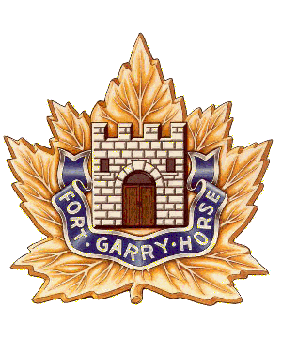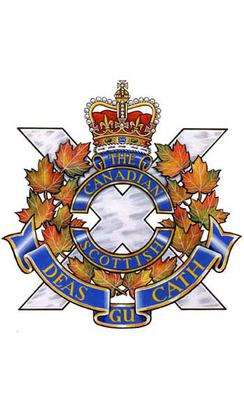Related Research Articles

The Royal Hamilton Light Infantry (Wentworth Regiment) (RHLI) is a Primary Reserve infantry regiment of the Canadian Army, based at John Weir Foote VC Armoury in Hamilton, Ontario. The RHLI is part of 31 Canadian Brigade Group, which is part of 4th Canadian Division.

The Fort Garry Horse is a Canadian Army Reserve armoured regiment based in Winnipeg, Manitoba, Canada. It is part of 3rd Canadian Division's 38 Canadian Brigade Group. It traces its history to a cavalry regiment first formed in 1912 that first took up the name "Fort Garry" a year afterwards. Since that time the regiment has served in the First World War, sending men to battalions of the Canadian Expeditionary Force, and as an armoured regiment in the Second World War.

The Nova Scotia Highlanders is an infantry regiment in the primary reserve of the Canadian Army. It is part of 36 Canadian Brigade Group, 5th Canadian Division.

The Royal Highland Fusiliers of Canada is a Primary Reserve light infantry regiment of the Canadian Army, with companies in Cambridge and Kitchener, and is an infantry sub-unit of 31 Canadian Brigade Group, headquartered in London, Ontario. The Princess Margaret, Countess of Snowdon and The Prince Andrew, Duke of York, as members of the Canadian Royal Family, acted as Colonel-in-Chief.

The North Saskatchewan Regiment is a Primary Reserve infantry regiment of the Canadian Army, headquartered in Saskatoon, Saskatchewan, with companies in Saskatoon and Prince Albert. Its current commanding officer is Lieutenant-Colonel Dennis Sansom, and the regimental sergeant-major is Chief Warrant Officer Jason Balcaen. The N Sask R is part of the 3rd Canadian Division's 38 Canadian Brigade Group.

The Canadian Scottish Regiment (Princess Mary's) is a Primary Reserve infantry regiment of the Canadian Army based on Vancouver Island in British Columbia.

The Royal Montreal Regiment is a Primary Reserve infantry regiment of the Canadian Army based in Westmount, Quebec. It is part of the 2nd Canadian Division's 34 Canadian Brigade Group.
The 152nd Battalion, CEF, was a unit of the Canadian Expeditionary Force during the Great War. It was authorized on 22 December 1915, recruiting in Weyburn and Estevan, Saskatchewan, and embarked for Great Britain on 3 October 1916, where its personnel were absorbed by the 32nd Reserve Battalion, CEF, on 21 October 1916 to provide reinforcements for the Canadian Corps in the field. The battalion was disbanded on 21 May 1917.

The Royal Regina Rifles is a Primary Reserve infantry regiment of the Canadian Army. Prior to 1982 the regiment was known as The Regina Rifle Regiment. The Royal Regina Rifles are part of 3rd Canadian Division's 38 Canadian Brigade Group.
The Prince Albert Volunteers (PAV) is the name of two historical infantry units headquartered in Prince Albert, Saskatchewan. The unit was first raised in 1885 during the North-West Rebellion and disbanded after hostilities ceased. In the 20th century, the unit was operational from 1913 to 1936 and 1941 to 1946. The PAV is now incorporated by amalgamation in the North Saskatchewan Regiment (N Sask R).

The Saskatchewan Dragoons is a Primary Reserve armoured regiment of the Canadian Army. The unit is based in Moose Jaw. Their primary job is to assist the Regular Force in meeting Canada's military commitments. Their training and equipment closely follow that of the Regular Force, which the Reserves are called upon to assist increasingly often. The Saskatchewan Dragoons are part of 3rd Canadian Division's 38 Canadian Brigade Group.

The 12th Manitoba Dragoons is an armoured regiment of the Canadian Army that is currently on the Supplementary Order of Battle.
The 1st Battalion, Canadian Mounted Rifles, CEF, was an infantry battalion of the Canadian Army. Raised for service during the First World War as part of the Canadian Expeditionary Force (CEF), it was formed in November 1914, in Brandon, Manitoba. Originally a mounted infantry unit named the 1st Regiment, Canadian Mounted Rifles, CEF, which was expanded, following its rerolling and dismounting as an infantry unit, by absorbing other units of the Canadian Mounted Rifles (CMR).

The 5th Battalion, CEF, known as "Tuxford's Dandys," was an infantry battalion of the Canadian Expeditionary Force during the Great War.

The 46th Battalion, CEF, was an infantry battalion of the Canadian Expeditionary Force during the Great War.
The 53rd Battalion, CEF, was an infantry battalion of the Canadian Expeditionary Force during the Great War. The 53rd Battalion was authorized on 7 November 1914 and embarked for Great Britain on 29 March 1916. It provided reinforcements for the Canadian Corps in the field until it was disbanded on 12 October 1917.
The 65th Battalion (Saskatchewan), CEF was an infantry battalion of the Canadian Expeditionary Force during the Great War. The 65th Battalion was authorized on 20 April 1915 and embarked for Great Britain on 18 June 1916. Its personnel were absorbed by the 44th Battalion (Manitoba), CEF, 46th Battalion, CEF, 54th Battalion (Kootenay), CEF and 72nd Battalion, CEF of the 4th Canadian Division on 30 June 1916. The battalion was disbanded on 12 October 1917.
The Manitoba Horse was a cavalry regiment of the Non-Permanent Active Militia of the Canadian Militia. First formed in 1912 as the 32nd Light Horse, the regiment was redesignated later that same year as the 32nd Manitoba Horse and again in 1920 as The Manitoba Horse. In 1936, the regiment was amalgamated with The Fort Garry Horse.
The North Saskatchewan Regiment was a short-lived infantry regiment of the Non-Permanent Active Militia of the Canadian Militia. In 1924, the regiment was reorganized and split up into 4 separate regiments.
The Saskatchewan Mounted Rifles was a cavalry regiment of the Non-Permanent Active Militia of the Canadian Militia. First formed in 1908 as the Saskatchewan Light Horse, the regiment was later redesignated that year as the 22nd Saskatchewan Light Horse and again in 1920 as The Saskatchewan Mounted Rifles. In 1911, the regiment transferred two of its squadrons to the newly formed 29th Light Horse. In 1936, the regiment was amalgamated with the 16th Canadian Light Horse to form the 16th/22nd Saskatchewan Horse.
References
- ↑ Canadian Forces Publication A-DH-267-003 Insignia and Lineages of the Canadian Forces. Volume 3: Combat Arms Regiments.
- Meek, John F. Over the Top! The Canadian Infantry in the First World War. Orangeville, Ont.: The Author, 1971.